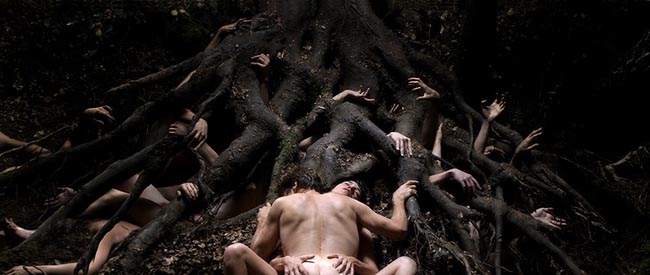 |
|
ARTS |
CULTURE |
|
Mission Newsletter |
|
With: Charlotte Gainsbourg, Willem Dafoe Review by Diego Costa, from Paris Calling Lars von Trier's Antichrist (2009) "torture porn" is like calling Citizen Kane (1941) a "televisual biopic," or Chris Marker's La Jetée (1962) "some slideshow." But that's how the film has been described by a pack of critics whose infantile logic seems to equate any nudity and violence to the most easily available ready-made label. Especially when the nudity here, as explicit as it may be, never eroticizes the female body and the violence maims the supposed bearer of the phallus (at least whenever it isn't self-inflicted).
Antichrist's aesthetics isn't as experimental again until its very end. Bracketed by these brilliant, green-lit pieces of hyper-slow-motion arias, it alternates between the poetic subtlety of Andrei Tarkovsky (to whom it is dedicated) and the heavy symbolism of low culture fare such as The Blair Witch Project (1999). The story is simple, perhaps even a little hackneyed. A couple whose baby falls onto his death while they make wild love; a woman trying to finish her thesis; a husband with a god complex. But Antichrist's genius is precisely in turning the banal predictability of its characters and the positions they occupy completely inside out, pitting Freud's "talking cure" against American behaviorist fantasies while it is at it. When Gainsbourg becomes pathologically depressed over the son's death her therapist husband takes her on as a patient. He engages her in a series of role-playing exercises aimed at curing her "fear." They then go through some nonsensical pen-and-paper business of trying to find the "feared object," which involves drawing a triangle whose top may indicate that she may "fear her own self." It is hard to tell if von Trier is consciously out to ridicule America's obsession toward the market-savvy scam that is instant-gratification therapy. But that is precisely what he does as the patient becomes the monster and the analyst its "objet a." The therapy sessions soon turn into a cat-and-mouse game as soon as the usual suspects reverse their roles. As woman starts to see arrogance in man's wisdom and vanity in his "froideur," she is the one to wield the ax, the saw and the pair of scissors. Man is reduced to a limping mound of flesh desperately seeking a rat hole to hide inside. And when woman finds him -- impotent and wounded, barely capable of choking a bird to death -- she doesn't know whether to kill him or rape him first. She ultimately castrates herself, as if to reveal the tautologically obvious: it was woman who had the phallus all along. |
(c)2008 - 2016 All contents copyrighted by AcousticLevitation.org. All contributors maintain individual copyrights for their works.
